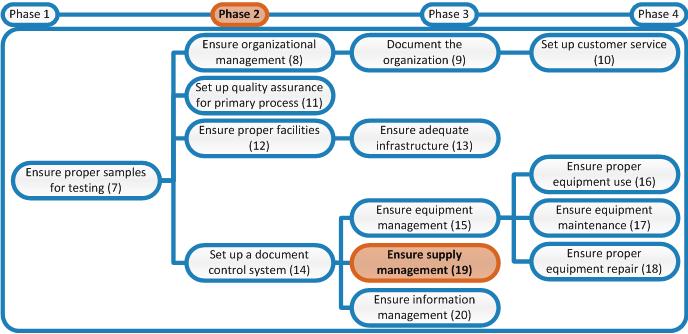
Title
Why
In general laboratories use a lot of supplies that have to be stored under different conditions. Some supplies need to be stored at -20°C, others at 5°C, and again others at room temperature (20°C). Storing supplies at the appropriate conditions prevents premature degradation of supplies. Storing them in an orderly fashion prevents damaging (e.g. due to supplies falling off shelves) and expiry of supplies.
Informing users of the contents and related hazards of storage areas and supply units prevents harmful situations.
What
Chapter 17 of the WHO Laboratory Biosafety Manual, 3rd edition contains essential background information on laboratory supply hazards and how to deal with these.
The following actions must be undertaken:
- Store supplies under the right conditions as indicated by the supplier (room temperature/5°C/-20°C/-70°C/etc.)
- Storage areas should comply with the necessary safety requirements as demanded by the nature of supplies. This means:
- Flammable supplies are stored in a fire-resistant cabinet
- Poisonous supplies are stored in a well-ventilated room/cabinet
- Corrosive substances are stored in corrosive resistant cabinets/trays/containers
- Liquid chemicals are stored in the lower part of safety cabinets, solid chemicals in the upper part
- Access to all storage areas must be restricted to authorized personnel only (this was arranged already in phase 1 in the activity where Stock Cards were prepared)
- Hazard symbols must be placed visibly on each storage area. Use the United Nations Globally Harmonized System of Classification and Labeling of Chemicals (GHS) system.
- Provide Material Safety Data Sheets (MSDS Sheets) for all the materials stored in each area. Keep these near the location where the items described in the MSDS Sheets are stored so that they are easily accessible for staff members
- When supplies are received record the following information:
- Name of the supply
- Preparation date/date of receipt
- Whether or not acceptance criteria were met and any follow-up actions
- Opening date (to be filled out when first opened)
- Expiry date (can often be found on internet if not visible on supply package)
- Possible safety warnings (Risk (R-) and Safety (S-) phrases; see reference document provided in the right-hand column of this page if not indicated already on the supply package
It is recommended to store the order form with the packing slip and record the above information on these records. This is because most of the above information is already indicated on these records. Store all the order forms and packing slips in the same folder.
- Store all supplies according to the FIFO system: First in-First out. This means that the lots of a supply that are nearest the expiration date or are the oldest are stored at the front of the shelf (so that they are taken first) and the newest lots are stored at the back of the shelf.
How & who
Stock Officer in collaboration with the Biosafety Officer:
- Read chapter 17 of the WHO Laboratory Biosafety Manual, 3rd edition.
- Determine if all supplies in the laboratory are stored under the right conditions. If not, relocate them to the proper storage area.
- Upon delivery/preparation, label each supply routinely with the details listed above.
- If necessary, restructure the storage areas so that all supplies are stored without fire risk, risk of falling of shelves or other types of damage.
- Store all the supplies according to the FIFO system.
- Determine which safety requirements each storage area must comply with:
- Make a list of changes that need to be made to storage areas to get them in compliance with the safety requirements. If new storage areas are needed (e.g. a fire-resistant cabinet) include that as well on the list. Also take into account that storage areas must protect the supplies from external influences such as light, insects, humidity, etc.
- Give this list to the laboratory manager who has to identify funding to finance the changes/purchase new areas.
- Once funds are available, translate the list of changes for upgrading the storage into SMART action points and combine them into an action plan called "Storage upgrading".
- Monitor the timely implementation of the action plan.
- Make sure that storage areas can be locked so that only authorized personnel can enter the areas.
- Determine for each storage area the potential hazards. Place the correct hazard symbols on the entrance to each storage area/on each storage cabinet.
- Refer to to the provided document with R- and S-sentences. Print enough copies of this list and place them in a visible location in/on each storage area. This way people can easily look up which R- and S-sentences apply to the supply they are taking from the storage.
- Explain in a weekly staff meeting what R- and S-sentences are and how staff members can find them.
Laboratory Manager:
The Stock Officer and Biosafety Officer will provide a list with changes that need to be made to storage areas in order to get them to comply with safety requirements.
- Determine, based on the necessary changes, how much money is needed and start searching for funds to finance the storage upgrading process.


